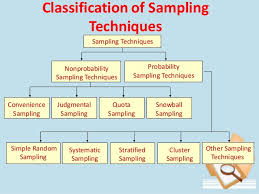Sampling Techniques
Partido, B.B.
Sampling is the process of selecting units (e.g., people, organizations) from a population of interest so that by  studying the sample we may fairly generalize our results back to the population from which they were chosen. External validity is related to generalizing, which is the degree to which the conclusions in a study would hold for other persons in other places and at other times. A threat to external validity is an explanation of how you might be wrong in making a generalization. There are three major threats to external validity because there are three ways you could be wrong — people, places or times.
studying the sample we may fairly generalize our results back to the population from which they were chosen. External validity is related to generalizing, which is the degree to which the conclusions in a study would hold for other persons in other places and at other times. A threat to external validity is an explanation of how you might be wrong in making a generalization. There are three major threats to external validity because there are three ways you could be wrong — people, places or times.
Probability Sampling
A probability sampling method is any method of sampling that utilizes some form of random selection. In order to have a random selection method, you must set up some process or procedure that assures that the each unit in your population has an equal probability of being chosen.

- Simple random sampling- Simplest form of random sampling. The procedure is to use a table of random numbers, a computer random number generator, or a mechanical device to select the sample.
- Stratified random sampling- Involves dividing your population into homogeneous subgroups and then taking a simple random sample in each subgroup.
- Systematic random sample- The procedure involves randomly selecting an integer (from 1 to k) and then taking every kth unit.
- Cluster random sampling- This procedure involves dividing the population into clusters (usually along geographic boundaries), randomly sampling clusters, and measuring all units within sampled clusters.
Nonprobability Sampling
Nonprobability sampling does not involve random selection and probability sampling does. With nonprobability samples, they may not represent the population well and it will often be hard to know how well it represents the population.
- Convenience sampling– In clinical practice, researchers may use clients who are available as the sample. There is no evidence that the sample is representative of the populations of interest.
- Quota sampling– People are selected nonrandomly according to some fixed quota. In proportional quota sampling you want to represent the major characteristics of the population by sampling a proportional amount of each. In nonproportional quota sampling, the minimum number of sample units wanted is selected in each category.
- Snowballing sampling– Someone is identified who meets the criteria for inclusion in the study. That person is asked to recommend others who they may know who also meet the criteria. Although this method would hardly lead to representative samples, there are times when it may be the best method available. Snowball sampling is especially useful when trying to reach populations that are inaccessible or hard to find.